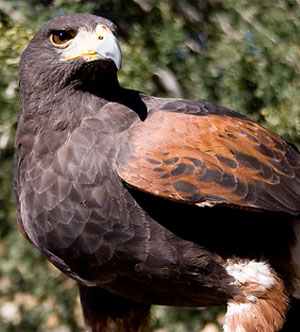Birds of Prey
What are birds of prey?

Any bird that eats other birds or animals is considered to be a 'bird of prey'. The term bird of prey is normally only applied to two groups, the first consisting of vultures, eagles, hawks and falcons. This group eats during the day.
The second group are known as 'nocturnal', which means that they sleep during the day and are awake at night, which is when they hunt. This group consists mostly of owls, which include the Tawny owl, Barn owl, Little owl, Long eared owl and the Snowy owl.
There are 421 species of birds of prey, 133 of them are owls. Birds of prey are one of the most threatened groups of birds. In the last 20 or 30 years the cutting down of forest and jungle, even small woodlands have destroyed their habitat.
Some birds of preys are looked at in more detail below.
Condors

Condors have become an endangered species due to loss of their habitat, shootings for sport, poisoning from pesticide residues, and collisions with power lines. They normally breed once every two years, producing only one egg, which also contributes towards the species becoming endangered due to a low reproductive rate.
Adult California condors are almost entirely black. Except for a few feathers, their heads and necks are mostly bare and include shades of pink, red, orange, yellow, and light blue, becoming more intensely pink when they are excited. And instead of flapping their wings Condors soar on wind currents, which can span more than nine feet from tip to tip.
Eagles

The world's 59 species of eagles are found on every continent except Antarctica. There are four major groups of eagles: fish eagles, booted eagles, snake eagles and giant forest eagles.
America's eagles are the Bald Eagle, which is a fish eagle, and the Golden Eagle, which is a booted eagle. Golden and Bald Eagles both reside in the United States.
Falcons

There are about 35 species of falcons, which is a Latin word meaning scimitar shaped, referring to the wing shape of falcons.
Most falcons have a rounded head with a short powerful beak, often with a notch in the top mandible. This notch is usually called a "falcon's tooth" and is used by the bird to dispatch their prey. Falcons have large dark eyes, and when at rest their long pointed wings can "cross" over their tail. Falcons range in size from the tiny Red-legged Falconet, which is the size of a sparrow, up to the Gyr Falcon which has a wingspan of nearly four and a half feet (1 .35m) and can weigh nearly four and a half pounds (2kg).
Falcons are renowned for their speed, and this can be attributed to the well-known Peregrine Falcon. As one of the most successful birds on the planet, the Peregrine is often endowed with almost supernatural powers of speed, strength, and ability.
Hawks

There are about 50 species of hawks, and most of them are either called Goshawks or Sparrow hawks. They are found across the world.
True hawks have glaring yellow, red or orange eyes. They have short rounded wings and a rather long tail. Generally a long lower leg (tarsus) which is bare. Many species are boldly coloured, often with pronounced ventral markings such as bars, stripes or similar. Entirely black specimens can be found, especially in tropical areas.
Most hawks are well adapted to hunting in dense bush. With rounded wings and a long tail, hawks are very manoeuvrable, allowing these birds to make agile dashes through relatively thick cover.
Vultures

There are 23 species of vulture in the world. There are seven species found in the New World (The Americas). The other 16 live in the Old World (Europe, Africa and Asia). They are absent from Australasia.
When they spread their wings the measurement from the tip of one to the other, the wingspan, is over 6 feet. They have bright red heads that are bald. When they fly, sometimes they pull their head and neck into the feathered ruff around their neck so that they don't lose a lot of body heat.
Vultures don't have a voice box, a pharynx, like other birds. They talk to each other by making hissing sounds. They make this sound by pushing air up through their windpipe and beak.